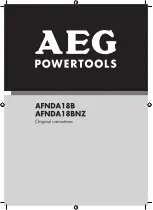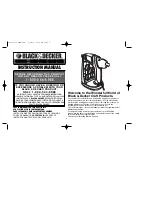
Cómo usar la
Clavadora
(Continuación)
7. Apriete el
gatillo y pre-
sione el
Elemento de
Contacto de Trabajo contra la
superficie de trabajo. La clavadora
NO DEBE hacerse funcionar.
8. Presione el
Elemento de
Contacto de
Trabajo con-
tra la superficie de trabajo. Apriete
el gatillo. La clavadora
DEBE OPER-
AR
.
Una
herramienta que funciona de manera
inadecuada no debe usarse. No active
la herramienta a menos que esté
colocada firmemente contra la pieza de
trabajo.
PARA CARGAR Y DESCARGAR LA
CLAVADORA
1. Siempre
conecte
la herramienta a
la fuente de suminsitro de aire
antes
de colocarle los clavos.
2. Empuje el
cierre hacia
abajo. Mueva
la tapa del car-
gador hacia
atrás.
3. Coloque una
serie de clavos
Campbell
Hausfeld o
equivalentes
(Vea la sección de clavos) en el car-
gador. Cerciórese de que los
extremos puntiagudos de los clavos
estén hacia la parte inferior del car-
gador. Cerciórese de que los clavos
no estén sucios ni dañados.
4. Tire la tapa del
cargador hacia
adelante hasta
que calce el
pestillo.
5. Siempre descargue el sujetador
antes de remover la herramienta de
!
ADVERTENCIA
servicio.
La descarga se hace
siguiendo
el proceso inverso de la
carga; sin embargo, siempre se
tiene que
desconectar
la
manguera de aire antes de descar-
garla.
CÓMO AJUSTAR LA PENETRACIÓN
DEL CLAVO
La IFN102 viene equipada con un
mecanismo clavador de profundidad
ajustable. Esto le permite al usuario
determinar a qué profundidad se va a
clavar en la superficie de trabajo.
1. Ajuste la presión de operación a aquél-
la que usará con regularidad para
clavar los clavos. No exceda la presión
de 6,90 bar.
2. Para dirigir el calador de clavos, gire
la rueda (C) hacia la derecha hasta
el punto deseado.
3. Para clavar el clavo más profundo,
gire la rueda (C) hacia la izquierda
hasta el punto deseado.
4. Asegúrese que el
gatillo y el Elemento
de Contacto de
Trabajo se mueven
libremente hacia
arriba y hacia abajo sin atascarse o
pegarse después de cada ajuste.
PARA AJUSTAR LA DIRECCION DEL
TUBO DE ESCAPE
La clavadora mod-
elo IFN102 está
equipada con un
deflector ajustable
de la dirección del
tubo de escape. Éste le permite al
usuario cambiar la dirección del tubo
de escape. Simplemente mueva el
deflector hacia la dirección deseada.
QUE HACER CUANDO LA CLAVADO-
RA TENGA UN CLAVO ATASCADO
1. Desconecte la
clavadora de la
fuente de sum-
inistro de aire.
2. Remueva todos
los clavos del
depósito (vea
Carga /
Descarga).
Si no se
retiran
todos los sujetadores éstos saldrán por el
frente de la herramienta.
3. Destrabe el gan-
cho presionando
el botón en el
lado del car-
gador. El botón
destrabará el
gancho de la boquilla.
4. Ahora se puede
girar la puerta,
dejando al descu-
bierto el sujeta-
dor que esté tra-
bado.
5. Retire todos
los sujeta-
dores que
estén traba-
dos, utilizan-
do unas pinzas o un destornillador
si fuera necesario.
6
Vuelva a girar la
puerta a su posi-
ción de cerrado.
7. Vuelva a presion-
ar el botón para
levantar el gan-
cho. Cierre la
puerta y suelte el
botón para volver a trabar el gan-
cho con la boquilla.
!
ADVERTENCIA
IFN102
5-Sp
Manual de Instrucciones
(C)
Operating The Nailer
(Continued)
1. The air com-
pressor must
be able to
maintain a
minimum of 60
psi when the
nailer is being used. An inadequate
air supply can cause a loss of power
and inconsistent
driving.
2. An oiler can be
used to provide oil
circulation through
the nailer. A filter
can be used to
remove liquid and solid impurities
which can rust or “gum up” internal
parts of the nailer.
3. Always use air supply hoses with a
minimum working pressure rating
equal to or greater than the pres-
sure from the power source if a reg-
ulator fails, or 150 psi, whichever is
greater. Use 3/8” air hose for runs
up to 50’. Use 1/2” air hoses for 50’
run or longer. For better perfor-
mance, install a 3/8” quick plug
(1/4” NPT threads) with an inside
diameter of .315” (8mm) on the
nailer and a 3/8” quick coupler on
the air hose.
4. Use a pressure regulator on the
compressor, with an operating pres-
sure of 0 - 125 psi. A pressure regu-
lator is required to control the oper-
ating pressure of the nailer
between 60 and 100 psi.
OPERATIONAL MODE
Always know the
operational mode
of the nailer before using. Failure to
know the operational mode could
!
WARNING
ger. The nailer
MUST NOT OPER-
ATE
. Do not use the tool if it oper-
ates without pulling the trigger.
Personal injury may result.
6. Remove the nailer
from the work sur-
face. The Work
Contact Element
(WCE) must return to
its original down position. The nail-
er
MUST NOT OPERATE
. Do not
use the tool if it operates while lift-
ed from the work surface. Personal
injury may result.
7. Pull the trig-
ger and
depress the
work contact
element (WCE) against the work
surface. The nailer
MUST NOT
OPERATE
.
8. Depress the
Work Contact
Element
(WCE) against
the work surface. Pull the trigger.
The nailer
MUST OPERATE
.
An improperly
functioning tool
must not be used. Do not actuate the
tool unless the tool is placed firmly
against the work piece.
LOADING/UNLOADING THE NAILER
1. Always
connect
the tool to the air
supply
before
loading fasteners.
2. Push down on
the latch. Pull
back on the
magazine cover.
3. Insert a stick of
Campbell
Hausfeld nails
or equivalent
(see "Fasteners" section) into the
magazine. Make sure the pointed
ends of the nails are resting on the
bottom ledge of the magazine
when loading. Make sure the nails
are not dirty or damaged.
!
WARNING
result in death or serious personal
injury.
SINGLE SEQUENTIAL MODE
This mode
requires the trig-
ger to be pulled
each time a nail
is driven. The nailer can be actuated by
depressing the Work Contact Element
(WCE) against the work surface fol-
lowed by pulling the trigger.
The trigger must be released to reset
the tool before another nail can be dri-
ven.
OPERATING A SEQUENTIAL TRIP
NAILER
Check the opera-
tion of the Work
Contact Element (WCE) trip mechanism
before each use. The WCE must move
freely without binding through its
entire travel distance. The WCE spring
must return the WCE to its fully extend-
ed position after being depressed. Do
not operate the nailer if the WCE trip
mechanism is not operating properly.
Personal injury
may occur.
1. Disconnect the
air supply from
the nailer.
2. Remove all
nails from the
magazine (see
Loading/ Unloading).
3. Make sure the trig-
ger and work con-
tact element (WCE)
move freely up and
down without sticking or binding.
4. Reconnect air
supply to the
nailer.
5. Depress the Work
Contact Element
(WCE) against the
work surface with-
out pulling the trig-
!
CAUTION
IFN102
Operating Instructions
4
www.chpower.com
60 psi
Min.
100 psi
Max.
150 psi or greater
3/8” I.D.
movement
1
2
1
2
Latch
1
2
1
2
Pestillo
movemiento
BUILT TO LAST
Gire






























